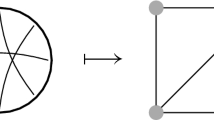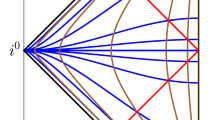Abstract
Weight systems on chord diagrams play a central role in knot theory and Chern–Simons theory; and more recently in stringy quantum gravity. We highlight that the noncommutative algebra of horizontal chord diagrams is canonically a star-algebra and ask which weight systems are positive with respect to this structure; hence, we ask: Which weight systems are quantum states, if horizontal chord diagrams are quantum observables? We observe that the fundamental \({\mathfrak {g}}{\mathfrak {l}}(n)\)-weight systems on horizontal chord diagrams with N strands may be identified with the Cayley distance kernel at inverse temperature \(\beta = \textrm{ln}(n)\) on the symmetric group on N elements. In contrast to related kernels like the Mallows kernel, the positivity of the Cayley distance kernel had remained open. We characterize its phases of indefinite, semi-definite and definite positivity, in dependence of the inverse temperature \(\beta \); and we prove that the Cayley distance kernel is positive (semi-)definite at \(\beta = \text {ln}(n)\) for all \(n = 1,2,3, \ldots \). In particular, this proves that all fundamental \({\mathfrak {g}}{\mathfrak {l}}(n)\)-weight systems are quantum states, and hence, so are all their convex combinations. We close with briefly recalling how, under our “Hypothesis H”, this result impacts on the identification of bound states of multiple M5-branes.

Similar content being viewed by others
Data availability
There is no further data associated with this work.
References
Altschuler, D., Freidel, L.: Vassiliev knot invariants and Chern-Simons perturbation theory to all orders. Commun. Math. Phys. 187, 261–287 (1997). ar**v:q-alg/9603010
Babai, L.: Spectra of Cayley graphs. J. Combin. Theor. B 27, 180–189 (1979). https://doi.org/10.1016/0095-8956(79)90079-0
Balachandran, A.P., Govindarajan, T.R., de Queiroz, A.R., Reyes-Lega, A.F.: Algebraic approach to entanglement and entropy. Phys. Rev. A 88, 022301 (2013). ar**v:1301.1300
Bar-Natan, D.: Perturbative aspects of the Chern–Simons topological quantum field theory. PhD thesis, Princeton University (1991). https://ncatlab.org/nlab/files/BarNatanPerturbativeCS91.pdf
Bar-Natan, D.: On the Vassiliev knot invariants. Topology 34(2), 423–472 (1995). https://doi.org/10.1016/0040-9383(95)93237-2
Bar-Natan, D.: Vassiliev and Quantum Invariants of Braids. The interface of knots and physics (San Francisco, CA, 1995), 129–144, Proc. Sympos. Appl. Math., vol. 51. AMS Short Course Lecture Notes, Amer. Math. Soc., Providence, RI (1996). ar**v:q-alg/9607001
Bar-Natan, D., Stoimenow, A.: The Fundamental Theorem of Vassiliev Invariants. In: Geometry and Physics, Lecture Notes in Pure & App. Math., vol. 184, Marcel Dekker Inc. (1996). ar**v:q-alg/9702009
Bar-Natan, D.: The Cayley distance kernel following ar**v:2105.0287 by Corfield, Sati, and Schreiber, https://drorbn.net/AcademicPensieve/2021-05/nb/CayleyDistanceKernel.pdf
Berkooz, M., Narayan, P., Simón, J.: Chord diagrams, exact correlators in spin glasses and black hole bulk reconstruction. J. High Energy Phys. 08, 192 (2018). ar**v:1806.04380
Berkooz, M., Isachenkov, M., Narovlansky, V., Torrents, G.: Towards a full solution of the large N double-scaled SYK model. J. High Energy Phys. 03, 079 (2019). ar**v:1811.02584
Chmutov, S., Duzhin, S., Mostovoy, J.: Introduction to Vassiliev Knot Invariants. Cambridge University Press (2012). ISBN:9781139107846, ar**v:1103.5628
Collari, C.: A note on weight systems which are quantum states. Can. Math. Bull. (2023) https://doi.org/10.4153/S0008439523000206ar**v:2210.05399
Diaconis, P.: Group representations in Probability and Statistics. Institute of Mathematical Statistics Lecture Notes Monogr. Ser. 11 (1988). jstor:i397389, https://jdc.math.uwo.ca/M9140a-2012-summer/Diaconis.pdf
Diaconis, P., Hanlon, P.: Eigen Analysis for Some Examples of the Metropolis Algorithm. In: Richards, D. (ed.) Hypergeometric Functions on Domains of Positivity, Jack Polynomials, and Applications. Contemporary Mathematics 138, Amer. Math. Soc. (1992), https://doi.org/10.1090/conm/138
Diaconis, P., Shahshahani, M.: Generating a random permutation with random transpositions. Z. Wahrscheinlichkeitsth. verw. Gebiete 57, 159–179 (1981). https://doi.org/10.1007/BF00535487
Drutu, C., Kapovich, M.: Geometric Group Theory. Colloquium Publications, vol. 63. Amer. Math. Soc. (2018) ISBN:978-1-4704-1104-6
Fiorenza, D., Sati, H., Schreiber, U.: Twisted Cohomotopy implies M-theory anomaly cancellation on 8-manifolds. Commun. Math. Phys. 377, 1961–2025 (2020). https://doi.org/10.1007/s00220-020-03707-2. ar**v:1904.10207
Fiorenza, D., Sati, H., Schreiber, U.: Twisted Cohomotopy implies M5 WZ term level quantization. Commun. Math. Phys. 384, 403–432 (2021). https://doi.org/10.1007/s00220-021-03951-0. ar**v:1906.07417
Fligner, M.A., Verducci, J.S.: Distance based ranking models. J. R. Stat. Soc. B 48(3), 359–369 (1986) jstor:2345433
Fligner, M.A., Verducci, J.S. (eds.): Probability Models and Statistical Analyses for Ranking Data, Lecture Notes in Statistics, vol. 80. Springer (1993). https://doi.org/10.1007/978-1-4612-2738-0
Foster-Greenwood, B., Kriloff, C.: Spectra of Cayley graphs of complex reflection groups. J. Algebraic Combin. 44(1), 33–57 (2016). https://doi.org/10.1007/s10801-015-0652-8. ar**v:1502.07392
Fulton, W.: Young Tableaux, with Applications to Representation Theory and Geometry. Cambridge University Press, Cambridge (1997). https://doi.org/10.1017/CBO9780511626241
Fulton, W., Harris, J.: Representation Theory: A First Course. Springer, Berlin (1991). https://doi.org/10.1007/978-1-4612-0979-9
Gnedin, A., Gorin, V., Kerov, S.: Block characters of the symmetric groups. J. Algebraic Comb. 38(1), 79–101 (2013). ar**v:1108.5044
Hofmann, T., Schölkopf, B., Smola, A.J.: Kernel methods in machine learning. Ann. Stat. 36(3), 1171–1220 (2008). ar**v:math/0701907
Hwang, S.-G.: Cauchy’s interlace theorem for eigenvalues of Hermitian matrices. Am. Math. Mon. 111(2), 157–159 (2004) jstor:4145217
Jahn, A., Eisert, J.: Holographic tensor network models and quantum error correction: a topical review. Quantum Sci. Technol. 6, 033002 (2021). ar**v:2102.02619
Jahn, A., Gluza, M., Pastawski, F., Eisert, J.: Majorana dimers and holographic quantum error-correcting code. Phys. Rev. Res 1, 033079 (2019). ar**v:1905.03268
Jiao, Y., Vert, J.-P.: The Kendall and Mallows Kernels for permutations. IEEE Trans. Pattern Anal. Mach. Intell. 40(7), 1755–1769 (2018). https://doi.org/10.1109/TPAMI.2017.2719680
Jucys, A.-A.: Factorization of Young projection operators for the symmetric group. Lietuvos Fizikos Rinkinys 11(1), 1–10 (1971). https://ncatlab.org/nlab/files/Jucys-1971.pdf
Jucys, A.-A.: Symmetric polynomials and the center of the symmetric group ring. Rep. Math. Phys. 5(1), 107–112 (1974). https://doi.org/10.1016/0034-4877(74)90019-6
Kadison, R.V., Ringrose, J.R.: Fundamentals of the theory of operator algebras I: Elementary Theory. Graduate Studies in Mathematics, vol. 15. Amer. Math. Soc. (1997). ISBN:978-0-8218-0819-1
Kaski, P.: Eigenvectors and spectra of Cayley graphs, Lecture notes, Postgraduate Course in Theoretical Computer Science, Helsinki (2002). www.tcs.hut.fi/Studies/T-79.300/2002S/esitelmat/kaski_paper_020506.pdf
Kohno, T.: Loop spaces of configuration spaces and finite type invariants. Geom. Topol. Monogr. 4, 143–160 (2002). ar**v:math/0211056
Kontsevich, M.: Vassiliev’s knot invariants. Adv. Sov. Math. 16, 2 (1993). http://pagesperso.ihes.fr/~maxim/TEXTS/VassilievKnot.pdf
James, G.D.: The Representation Theory of the Symmetric Groups. Lecture Notes in Mathematics, vol. 682. Springer, Berlin (1978)
Landsman, K.: Foundations of quantum theory: From classical concepts to Operator algebras. Springer Open (2017). https://doi.org/10.1007/978-3-319-51777-3
Lovász, L.: Spectra of graphs with transitive groups. Period. Math. Hung. 6, 191–195 (1975). https://doi.org/10.1007/BF02018821
Mairal, J., Vert, J.-P.: Machine Learning with Kernel Methods. Lecture Notes (2017). http://members.cbio.mines-paristech.fr/~jvert/svn/kernelcourse/course/2021mva
McNamara, S.: Twistor Inspired Methods in Perturbative Field Theory and Fuzzy Funnels, PhD thesis, Queen Mary, U. of London (2006). spire:1351861
Meyer, P.-A.: Quantum Probability for Probabilists. Lecture Notes in Mathematics, vol. 1538. Springer (1995). https://doi.org/10.1007/BFb0084701
Milnor, J., Moore, J.: On the structure of Hopf algebras. Ann. Math. 81, 211–264 (1965). https://doi.org/10.2307/1970615
McNamara, S., Papageorgakis, C., Ramgoolam, S., Spence, B.: Finite N effects on the collapse of fuzzy spheres. J. High Energy Phys. 0605, 060 (2006). ar**v:hep-th/0512145
Murphy, G.E.: A new construction of Young’s seminormal representation of the symmetric groups. J. Algebra 69(2), 287–297 (1981). https://doi.org/10.1016/0021-8693(81)90205-2
Narovlansky, V.: Towards a Solution of Large N Double-Scaled SYK. Seminar Notes (2019). https://ncatlab.org/nlab/files/NarovlanskySYK19.pdf
Selinger, P.: A survey of graphical languages for monoidal categories. In: Coecke, B. (ed.) New Structures for Physics. Lecture Notes Phys., vol. 813. Springer, Berlin (2010). https://doi.org/10.1007/978-3-642-12821-9_4, ar**v:0908.3347
Ramgoolam, S., Spence, B., Thomas, S.: Resolving brane collapse with 1/N corrections in non-Abelian DBI. Nucl. Phys. B 703, 236–276 (2004). ar**v:hep-th/0405256
Rockmore, D., Kostelec, P., Hordijk, W., Stadler, P.F.: Fast Fourier transform for fitness landscapes. Appl. Comput. Harmon. Anal. 12, 57–76 (2002). https://doi.org/10.1006/acha.2001.0346
Sagan, B.: The Symmetric Group. Springer, Berlin (2001). https://doi.org/10.1007/978-1-4757-6804-6
Sati, H.: Framed M-branes, corners, and topological invariants. J. Math. Phys. 59, 062304 (2018). https://doi.org/10.1063/1.5007185. ar**v:1310.1060]
Sati, H., Schreiber, U.: Equivariant Cohomotopy implies orientifold tadpole cancellation. J. Geom. Phys. 156, 103775 (2020). https://doi.org/10.1016/j.geomphys.2020.103775. ar**v:1909.12277
Sati, H., Schreiber, U.: Differential Cohomotopy implies intersecting brane observables via configuration spaces and chord diagrams. Adv. Theor. Math. Phys. 26(4), 957–1051 (2022). https://doi.org/10.4310/ATMP.2022.v26.n4.a4. ar**v:1912.10425
Sati, H., Schreiber, U.: Twisted Cohomotopy implies M5-brane anomaly cancellation. Lett. Math. Phys. 111, 120 (2021). https://doi.org/10.1007/s11005-021-01452-8. ar**v:2002.07737
Sati, H., Schreiber, U.: The character map in equivariant twistorial Cohomotopy implies the Green-Schwarz mechanism with heterotic M5-branes, ar**v:2011.06533
Sati, H., Schreiber, U.: M/F-Theory as Mf-Theory. Rev. Math. Phys. (2023, in print) ar**v:2103.01877
Stanley, R.: Theory and application of plane partitions 2. Stud. Appl. Math. 50(3), 259–279 (1971)
Stanley, R.: Enumerative combinatorics, vol. 1. Cambridge University Press 2011 (1986). ISBN:9781107602625, http://www-math.mit.edu/~rstan/ec/ec1.pdf
Stanley, R.: Enumerative combinatorics, vol. 2. Cambridge University Press (1999). https://doi.org/10.1017/CBO9780511609589
Sternberg, S.: Group Theory and Physics. Cambridge University Press, Cambridge (1994). ISBN:9780521558853
Yan, H.: Geodesic string condensation from symmetric tensor gauge theory: a unifying framework of holographic toy models. Phys. Rev. B 102, 161119 (2020). ar**v:1911.01007
Acknowledgements
We thank Abdelmalek Abdesselam, Dror Bar-Natan, Carlo Collari, Jean-Philippe Vert and David Speyer for comments and discussion. Collari has meanwhile built on our result in [12].
Author information
Authors and Affiliations
Corresponding author
Ethics declarations
Conflict of interest
The authors declare that they have no conflict of interest.
Additional information
Publisher's Note
Springer Nature remains neutral with regard to jurisdictional claims in published maps and institutional affiliations.
The authors acknowledge support by Tamkeen under the NYU Abu Dhabi Research Institute Grant CG008.
Rights and permissions
Springer Nature or its licensor (e.g. a society or other partner) holds exclusive rights to this article under a publishing agreement with the author(s) or other rightsholder(s); author self-archiving of the accepted manuscript version of this article is solely governed by the terms of such publishing agreement and applicable law.
About this article
Cite this article
Corfield, D., Sati, H. & Schreiber, U. Fundamental weight systems are quantum states. Lett Math Phys 113, 112 (2023). https://doi.org/10.1007/s11005-023-01725-4
Received:
Revised:
Accepted:
Published:
DOI: https://doi.org/10.1007/s11005-023-01725-4




